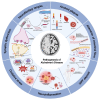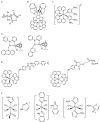Mechanism of Metal Complexes in Alzheimer's Disease
- PMID: 39595941
- PMCID: PMC11593898
- DOI: 10.3390/ijms252211873
Mechanism of Metal Complexes in Alzheimer's Disease
Abstract
Alzheimer's disease (AD) is a kind of neurodegenerative diseases characterized by beta-amyloid deposition and neurofibrillary tangles and is also the main cause of dementia. According to statistics, the incidence of AD is constantly increasing, bringing a great burden to individuals and society. Nonetheless, there is no cure for AD, and the available drugs are very limited apart from cholinesterase inhibitors and N-Methyl-D-aspartic acid (NMDA) antagonists, which merely alleviate symptoms without delaying the progression of the disease. Therefore, there is an urgent need to develop a medicine that can delay the progression of AD or cure it. In recent years, increasing evidence suggests that metal complexes have the enormous potential to treat AD through inhibiting the aggregation and cytotoxicity of Aβ, interfering with the congregation and hyperphosphorylation of tau, regulating dysfunctional synaptic and unbalanced neurotransmitters, etc. In this review, we summarize the current metal complexes and their mechanisms of action for treating AD, including ruthenium, platinum, zinc, vanadium, copper, magnesium, and other complexes.
Keywords: Alzheimer’s disease; mechanism; metal complexes; therapeutics.
Conflict of interest statement
The authors declare no conflicts of interest.
Figures











Similar articles
-
Therapy and diagnosis of Alzheimer's disease: from discrete metal complexes to metal-organic frameworks.J Mater Chem B. 2023 Aug 2;11(30):7024-7040. doi: 10.1039/d3tb00427a. J Mater Chem B. 2023. PMID: 37435638 Review.
-
Metal Ions and Metal Complexes in Alzheimer's Disease.Curr Pharm Des. 2016;22(26):3996-4010. doi: 10.2174/1381612822666160520115248. Curr Pharm Des. 2016. PMID: 27197799 Review.
-
Metal ions influx is a double edged sword for the pathogenesis of Alzheimer's disease.Ageing Res Rev. 2017 May;35:265-290. doi: 10.1016/j.arr.2016.10.003. Epub 2016 Nov 6. Ageing Res Rev. 2017. PMID: 27829171 Review.
-
Amyloid β-targeted metal complexes for potential applications in Alzheimer's disease.Future Med Chem. 2018 Mar 1;10(6):679-701. doi: 10.4155/fmc-2017-0248. Epub 2018 Feb 5. Future Med Chem. 2018. PMID: 29400551 Review.
-
Metal Ions in Alzheimer's Disease: A Key Role or Not?Acc Chem Res. 2019 Jul 16;52(7):2026-2035. doi: 10.1021/acs.accounts.9b00248. Epub 2019 Jul 5. Acc Chem Res. 2019. PMID: 31274278
References
Publication types
MeSH terms
Substances
LinkOut - more resources
Full Text Sources
Medical

